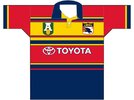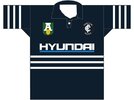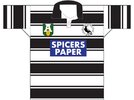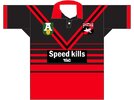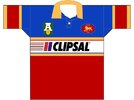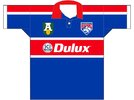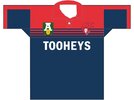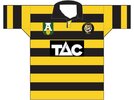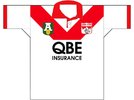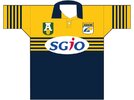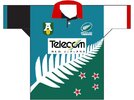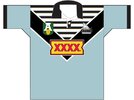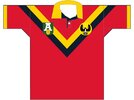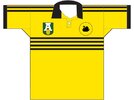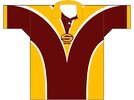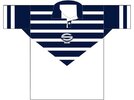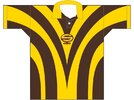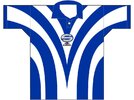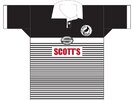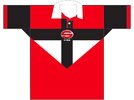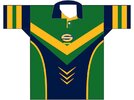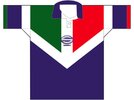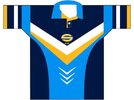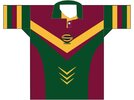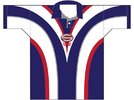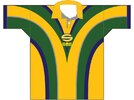With deference to Freight Train and cannavo for the EA AFL 2000 and "Time Traveller Sneezes" (respectively) inspiration. They are much better than I am so make sure you check them out.
A time traveller sneezes and bringsCOVID-19 chaos to the world we thought we knew. Somehow, the history of Aussie rules has been changed and resembles a different sport that may have existed in a different universe, but doesn’t in this one… stay with me. You join our story, already in progress.
The year is 1997. For years, Australian football has been locked in the courtrooms in a battle of the billionaires. False starts, failed peace offerings and lucrative, secretive dealings have led to a schism in the game.
For over a century, the Victorian Football League was the sport’s premier competition, later expanding across state lines and establishing itself, under the Australian Football League branding, as the national league.


VFL logo (left), used prior to rebrand to AFL (right)
With the advent of pay television, the Seven Network, AFL’s long-time broadcast rights holders and minority partners in Optus Vision’s Sports Australia channels, came to an agreement to provide Optus Vision with exclusive rights to games that would otherwise not be aired on free-to-air TV.
Looking to bolster Foxtel’s fledgling Fox Sports channels, Rupert Murdoch’s News Corporation and telecommunications giant Telstra, partners in the Foxtel service, began trying to sign clubs and players to launch their own competition, having been locked out of negotiations by the Seven-Optus consortium.

Super League logo
In 1997, the competition will be split into the AFL and the Super League.
Events off the field:
A time traveller sneezes and brings
The year is 1997. For years, Australian football has been locked in the courtrooms in a battle of the billionaires. False starts, failed peace offerings and lucrative, secretive dealings have led to a schism in the game.
For over a century, the Victorian Football League was the sport’s premier competition, later expanding across state lines and establishing itself, under the Australian Football League branding, as the national league.
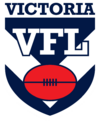
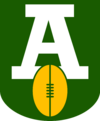
VFL logo (left), used prior to rebrand to AFL (right)
With the advent of pay television, the Seven Network, AFL’s long-time broadcast rights holders and minority partners in Optus Vision’s Sports Australia channels, came to an agreement to provide Optus Vision with exclusive rights to games that would otherwise not be aired on free-to-air TV.
Looking to bolster Foxtel’s fledgling Fox Sports channels, Rupert Murdoch’s News Corporation and telecommunications giant Telstra, partners in the Foxtel service, began trying to sign clubs and players to launch their own competition, having been locked out of negotiations by the Seven-Optus consortium.

Super League logo
In 1997, the competition will be split into the AFL and the Super League.
Events off the field:
- Super League makes a massive financial offer to the MCC for exclusive access to the MCG. The AFL threaten to move the Grand Final to Waverley if the MCC allow ANY access to the ‘G. Super League is granted use for the Home and Away season only but not for any Finals. The AFL back down and will host their 1997 Grand Final at the ‘G.
- Super League announces it will counter the State of Origin series with its own All Stars match, pitting Melbourne “origin” players against the rest of the nation.
- Super League, having been locked out of the MCG for Finals matches, announces plans to build a new stadium by 2000 in the dilapidated Docklands area of Melbourne. Initial plans suggest a domed stadium, but this is unlikely given the cost…
- Having previously announced interest in an amalgamation, the Fitzroy and Brisbane clubs withdraw from their planned merge given Fitzroy’s wish to remain in the AFL and Brisbane’s to jump to the new competition. The AFL agree to bail out the Roys, in exchange for taking over its administration, and agree to indemnify the club from having to merge or relocate for 5 years in AFL competition.
- Having lost its Queensland club to SL, the AFL partner with Southport to launch the South Queensland Sharks, playing out of Carrara.
- Super League gets its first Victorian club, Geelong, having committed to funding redevelopment of Kardinia Park in order to build a Victorian headquarters and secondary stadium (along with the planned Docklands development).
- Hawthorn, North Melbourne and St Kilda are also lured to Super League, promised immunity (along with Geelong) from any potential merger or amalgamation for 10 years under Super League administration.
- Originally expressing interest in joining the Super League competition, the Sydney Swans (formerly South Melbourne) decide to remain loyal to the AFL. The SCG Trust previously announced it would lock any Super League football out of the ground, handcuffing the Swans who would be without a home ground.
- With the Swans’ late backflip, a New South Wales team is launched by the Super League. The team negotiates with the Royal Agricultural Society of NSW to play out of the Sydney Showground, adjacent to the SCG, as well as gaining access to the new Showground being built for the Olympics when the RAS gets the keys. Plans are also made to take certain games to North Sydney, Newcastle and Coffs Harbour in anticipation of possible expansion in future SL seasons.
- After the SANFL and Crows remain loyal to the AFL, Port Adelaide withdraw from the SANFL, revoke their bid to join the AFL and fully commit to the Super League. They will enter SL as the only existing club from outside of the AFL.
- While the West Coast Eagles initially express interest in the Super League, the WAFL fail to secure the Super League “Super Final” as planned, with Super League planning to have the higher-ranked team host it, and remain loyal to the AFL.
- The Super League entice Fremantle to join and ensure SL’s presence in the West. Freo will play out of the WACA after being locked out of Subiaco by the WAFC.
- The AFL launch a pre-emptive strike to Super League’s expansion plans by launching a New Zealand franchise, initially based out of McLean Park in Napier but with the aim to move to the planned new Wellington stadium once completed. The AFL commit funds to assist in the construction and secure their 12th club.
- Super League launches a franchise in Canberra, initially playing out of Bruce Stadium with plans for a renovation of Manuka Oval to allow for the ACT’s plans to convert Bruce into a rectangular stadium for the 2000 Olympics.
- Super League launches another franchise, this time in Tasmania and ensuring that SL is the only leaguer with a presence in every state. The side will play out of North Hobart Oval with the blessing of the Tasmanian administration, who also align with Super League, the first state to do so. This gives the Super League its 10th club.
- The Super League signs an agreement with part-News-owned Ansett Australia to serve as the official airline partner of the new league. The AFL hastily signs an arrangement with Qantas to do the same. Both airlines receive naming rights to the respective Premiership competitions in exchange for free transport for their clubs.








